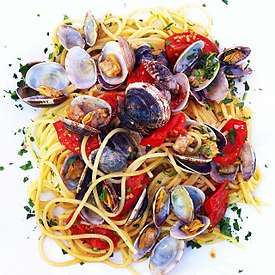Italian Eritrean cuisine
 |
| Italian cuisine |
|---|
|
|
Italian Eritrean cuisine is the mix of Eritrean dishes and spices with Italian dishes.
Characteristics
This kind of cuisine is quite common with Italian Eritreans or simply Italians who live in Eritrea and vice versa. A common dish is 'Pasta al Sugo e Berbere', which means "Pasta with tomato sauce and berbere" (spice), but there are many more like "lasagna" and "cotoletta alla milanese" (milano cutlet.) Italian influence is also apparent in Eritrea's beverages, and freshly roasted and brewed Italian-style coffee is commonly enjoyed, along with honey wine and a home-brewed beer called "Suwa".
History
The Italian Eritrean cuisine started to be practiced during the colonial times of the Kingdom of Italy, when a large number of Italians moved to Eritrea. They brought the use of "pasta" to Italian Eritrea, and it is a staple food eaten in present-day Asmara. Indeed, cuisine in Eritrea features more Ottoman and Italian influences than are present in Ethiopian cooking, including more pasta dishes and greater use of curry powders and cumin.[1]
Eritrean restaurants include more Italian options, such as spaghetti or lasagna, in what amounts to a hearty embrace of their former colonial rulers. The Italians, after all, gave Eritrea not only a name and a suspiciously Italy-shaped border, but they also gave Eritreans an easily grasped identity—and therefore, arguably, their first taste of nationalistic pride. Tim Carman[1]
It is more common to find people eating the Italian Eritrean cuisine in the capital, Asmara. Asmara has been regarded as "New Rome" or "Italy's African City" due to its Italian influence, not only in the architecture, but also for the wide streets, piazzas and coffee bars. In the boulevards, lined with palms and indigenous shiba'kha trees, there are many pizzerias and coffee bars, [2] serving cappucinos and lattes, as well as gelato parlours. Many Eritreans drink the espresso coffee, made using original Italian machinery.
Notes
- 1 2 Carman, Tim (9 January 2009). "Mild Frontier: the differences between Eritrean and Ethiopian cuisines come down to more than spice". Washington City Paper. Retrieved 12 March 2013.
- ↑ Splinter, Hans van der. "Asmara - bars and pastry's". www.asmera.nl. Retrieved 2018-04-09.
Bibliography
- Capatti, Alberto and Montanari, Massimo. Italian Cuisine: a Cultural History. New York: Columbia University Press, 2003. ISBN 0-231-12232-2
- Dickie, John. Delizia! The Epic History of Italians and Their Food (New York, 2008)